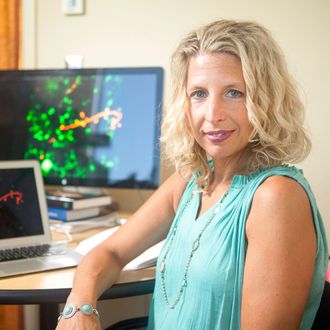
You have fewer synapses in your brain now than a 2-year-old. That may sound like an insult, but it’s a scientific fact. We’re all born with heads full of lonely, isolated neurons. But as our baby brains are inundated with sensory information over the first two years of life, those neurons rapidly form connections, or synapses. A toddlers’ brain teems with more than 100 trillion of them. By the time that toddler becomes an adult, though, the brain will have pared back roughly half of them — synapses that are used frequently become stronger, while those that aren’t wither away.
This process of overproduction followed by winnowing allows the brain to shape itself to its environment. As neuroscientist David Eagleman writes, “You become who you are not because of what grows in your brain, but because of what’s removed.”
Neuroscientists have known about so-called synaptic pruning for a long time. But in 2012, Harvard University neuroscientist Dr. Beth Stevens made a discovery that transformed her field’s understanding of the mechanisms behind the process. Stevens’s contribution was so profound, the MacArthur Foundation awarded her one of its coveted “genius” grants last night.
Her work centers on non-neuronal brain cells called microglia. Before Stevens’s research, microglia were seen solely as a part of the brain’s immune system, sweeping out cellular debris, pathogens, and damaged tissue. But Stevens found that these little guys weren’t merely the brain’s custodians — they were also its architects.
She discovered that another breed of “glial” cells, called “astrocytes,” trigger immature synapses — synapses that haven’t been developed because of their lack of use — to produce an immune protein that functions as an “eat me” sign. Microglia then travel around the brain gobbling up these excess connections, maximizing the efficiency of the brain’s wiring.
Stevens’s discovery has the potential to open up new lines of attack against disorders caused by faulty neural architecture, like schizophrenia, as well as those caused by neurodegeneration, like Alzheimer’s and Huntington’s. Previously, neuroscientists had focused primarily on the role nerve cells play in constructing the brain’s circuitry, and thus looked to find solutions for faulty wiring through the study of such cells. In establishing the influence of the brain’s immune cells on its circuitry, Stevens has opened up a whole new battlefield for researchers.
Her work is particularly promising for autism research. Earlier studies have suggested that microglia are more active and synapses more abundant in the brains of people on the spectrum, and Stevens is currently studying the activity of microglia in the brains of mice with conditions analogous to human autism. With the MacArthur Foundation’s funding — $625,000 over five years with no strings attached — Stevens will be able to keep pruning away at her field’s tangled hypotheses.





